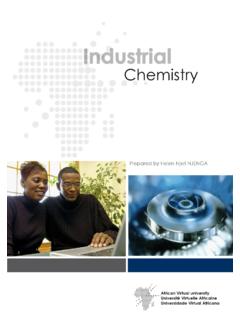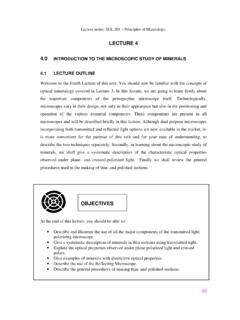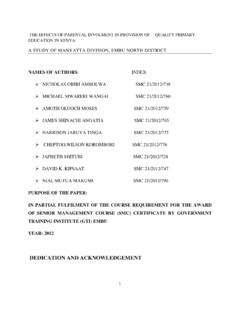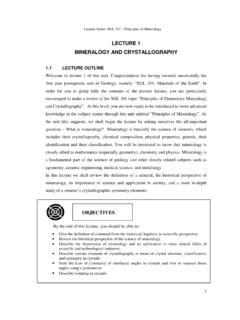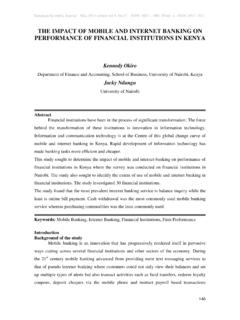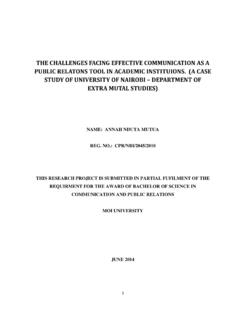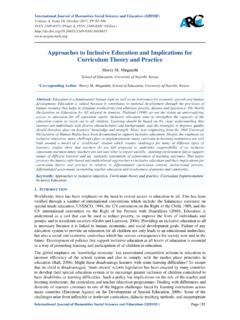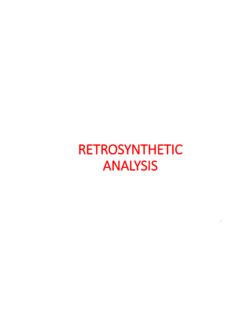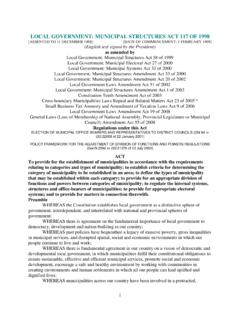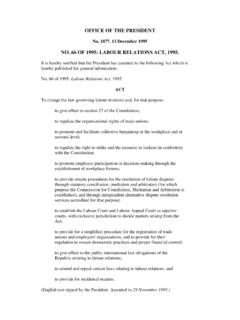Transcription of KENYA-SOMALIA MARITIME TERRITORIAL DISPUTE: WHY …
1 1 KENYA-SOMALIA MARITIME TERRITORIAL DISPUTE: WHY SOMALIA TOOK KENYA TO THE IINTERNATIONAL COURT OF JUSTICE, ADVANTAGES, LIMITATIONS AND EXISTING MODES OF PEACEFUL SETTLEMENT? Dr. Mumma-Martinon: Department of Political Science and Public Administration (University of Nairobi) Mob. + (254) 718741793/ 720794226 Email: Key Words: International Disputes, MARITIME TERRITORIAL Disputes, Legal differences, Political differences, International Court of Justice, Peaceful Settlement of International Disputes. INTRODUCTION Tensions between Kenya and Somalia have been there since the colonial times. However, overt disputes were not experienced until 2014 when Somalia took Kenya to the International Court of Justice (ICJ), claiming that Kenya is encroaching on its sea territory, an off shore area of 100,000 square kilometres.
2 This was on the premise that both countries recognize the Court s obligatory jurisdiction as per Article 36 (2) of the ICJ s Statute, also referred to as the optional clause declarations . This Article provides that all states party to the present Statute may at any time declare that they recognize as compulsory and without special agreement, in relation to any other state accepting the same obligation, the jurisdiction of the Court in all legal disputes1. Whereas Somalia wants the boundary defined by the ICJ, as stipulated by the United Nations Convention on the Law of the Sea (UNCLOS), as well as other global laws, Kenya has stuck to its guns on its preferred border demarcation according to the 1979 decree.
3 The question this paper is asking therefore is; what prompted Somalia to take Kenya to ICJ, what are the advantages and limitations of the ICJ and what other peaceful modes of settlement exist? THE AREA UNDER DISPUTE The area under dispute is a triangular patch of 100,000 km2 (about 62,000 square miles) that comes about from projecting the KENYA-SOMALIA common border eastwards. It is not clear which country could be the rightful owner of the contested area. 2 Map of Kenya and Somalia Depicting the Disputed Areas Source: Mohamed Isse Trunji, March 14, 2017 CLAIMS OF THE TWO COUNTRIES AT THE INTERNATIONAL COURT OF JUSTICE Somalia is asking the ICJ not only to extend the continental shelf, but also to fix a line which touches and divides the TERRITORIAL sea between her and Kenya and the Economic Exclusive Zone (EEZ).
4 Somalia feels that Kenya has violated its international obligations and does not respect Somalia s TERRITORIAL sovereignty and must be made to make full reparation to Somalia. Kenya, on the other hand, is claiming that in 1979, a Memorandum of Understanding (MoU)2, was signed between the two countries, which gave her jurisdiction over the disputed areas and she is also asking why Somalia did not object to this claim over all the years that they have had diplomatic relations, what has changed? Kenya is pushing for the border to run on parallel latitude from a point in the south-east of Kyunga. She claims that the boundary corresponds to the line of latitude eastwards.
5 Somalia is in favour of a diagonal trajectory running down the Coast of Kenya, insisting that the border needs to proceed on the same south-easterly trajectory, as a projection of the shore border, into the ocean. 3 In October 2015, Kenya made two separate objections, in a bid to challenge the Court s Jurisdiction to handle the case and its admissibility:3 First, Kenya argued that there was a signed MoU between the two countries in 1979, which established an arrangement providing for different methods of settlement and that gave her the jurisdiction over the disputed area. She claims that by taking her to ICJ, Somalia is going against the status of recognition and mutual respect of the sea border along the parallel latitude.
6 According to the Kenyan authorities, the dispute was further escalated in February 2019, when Somalia went ahead to auction oil-prospecting rights in the heart of the contested area. Consequently, Kenya demanded that Somalia discards a map that was exhibited in an economic forum held in London, which depicted the contested triangle as belonging to Somalia. Similarly, Kenya demanded that Somalia notifies the potential investors that it does not own the contested oil blocks within the disputed area and hence has no authority to reach any deal with them. STATUS OF THE CASE AT THE INTERNATIONAL COURT OF JUSTICE The primary function of the United Nations is to maintain international peace and security globally.
7 The United Nations does this using three means (1) By creating and maintaining conditions which can bring peaceful relations and a general feeling of security among the UN member states ; (2) through peaceful settlement of disputes or adjusting those international disputes or situations that are likely to be a threat to friendly relations among states; (3) through various actions which suppress or prevent any threats to international peace. The ICJ held its maiden hearing of Kenya s petition on September 19th to 20th, 2016. Regarding the first objection made by Kenya, the Court decided to determine the legitimacy of the MoU signed by the two countries, before considering what it contained.
8 In its ruling on the Preliminary Objections made on 2nd February 2017 by Kenya, the Court found the MoU to be insignificant on three grounds: i) it did not have any commitments or requirements on how the conflict should be determined ii) if Kenya really thought that delimitation was only to come after delineation, it would not have started those discussions iii) the 6th paragraph of the MoU did not have the role of dispute determination as claimed by Kenya. Relying on Article 282 of the UNCLOS, Kenya had reservations on the jurisdiction of the Court and mandate over this dispute. Regarding this, the Court reasoned that if at all the intent to exclude its jurisdiction existed; then there would have been some dispute about it.
9 The Court, hence, found itself to have jurisdiction over the matter at hand, affirming its suitability to hear the case and effectively squashing Kenya s plea. The conclusion of the Court was that reasserting the Court s jurisdiction came with the advantage of evading any disagreeable disputes of jurisdiction in future. 4 As things are at the moment, there is a high possibility that the Court could end up deciding on who owns the contested MARITIME area a decision that will most likely end up favouring only one of the two countries. ADVANTAGES OF THE INTERNATIONAL COURT OF JUSTICE Impartiality, Professionalism, Rules and Regulations The prestige of the Court depends not only on its impartiality, but also on the skill and conscientiousness with which its tasks are performed, and on the professional and personal standing of its members, most of whom before coming to the bench had distinguished themselves as renowned scholars, judges, or legal advisers to governments, and had acquired wide recognition.
10 The Court is thus expected to give a careful and thorough consideration to the issues on which it has to pass. The relatively small number of cases submitted each year to the Court enables it to live up to a high standard of thoroughness, even if the conciseness of some of its opinions does not always make this evident. 4 Consent of Parties The basis under which the Court has jurisdiction over international disputes 5submitted to it lies in the principle of the consent of parties. This consent can be given either (1) by a declaration that recognizes the fact that the Court has jurisdiction, with or without limitation, under the "optional clause" of Article 36 of the Statute, or (2) by the parties recognizing as compulsory the jurisdiction of the Court over any future disputes, or (3) by the parties agreeing to submit a particular dispute to the Court.
